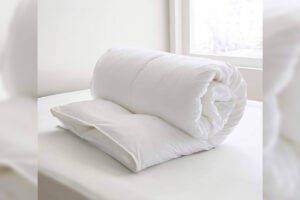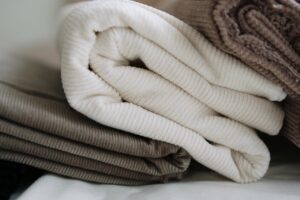Clothes alteration services are temporarily unavailable at all locations.
Does Washing at 60 Damage Clothes? Here’s the Truth
- By White's Laundry
- 30 September 2025
When it comes to doing laundry, one of the most common questions people have is about water temperature. Many believe that hotter washes mean cleaner clothes, but is that always true? Specifically, does washing at 60°C damage clothes, or is it necessary for proper hygiene?
The short answer: washing at 60°C can be effective for disinfecting clothes, but it may also harm certain fabrics if used too often or incorrectly. Let’s explore when it’s beneficial, when to avoid it, and how to wash safely at this temperature.
Why Temperature Matters in Laundry
Temperature plays a key role in how well your clothes are cleaned. Higher temperatures help break down oils, kill bacteria, and remove tough stains. On the other hand, cooler washes are gentler on fabrics, colours, and energy use.
Most washing machines today allow you to choose between 30°C, 40°C, and 60°C cycles, and that choice can make a big difference in how your clothes look and last.
Understanding What Washing at 60°C Does
A 60°C wash (or 140°F) is considered a high-temperature cycle. It’s typically used for heavily soiled or germ-prone items such as towels, bedsheets, baby clothes, or cleaning cloths. At this temperature:
- Bacteria and viruses are effectively killed
- Grease and oil stains are broken down more easily
- Detergent enzymes work more efficiently against stubborn dirt
However, the same heat that sanitizes can also stress fabrics, fade colours, and cause shrinkage, especially when used repeatedly.
So, while a 60°C wash is excellent for hygiene, it’s not suitable for every load.
Does Washing at 60 Damage Clothes?
The honest answer: it depends on the fabric type.
High temperatures cause the fibres in certain materials to contract, fade, or weaken over time. Here’s how common fabrics respond to washing at 60°C:
Cotton
Most cotton items can tolerate 60°C, especially white towels, bed linen, and undergarments. However, coloured cotton garments may fade faster if frequently exposed to high temperatures.
Synthetics (Polyester, Nylon, Spandex)
Synthetic fabrics are sensitive to heat. Washing them at 60°C can cause stretching, loss of shape, or damage to elastic fibres. Sportswear and leggings should generally be washed at 30–40°C.
Wool and Silk
Natural delicate fibres like wool and silk can shrink or become misshapen when exposed to high heat. Always check the care label; these fabrics should typically be washed on a cool or gentle cycle.
Denim
Denim can usually withstand warmer washes, but frequent high-temperature washing can cause it to fade faster and lose its soft feel.
In summary, washing at 60°C can damage clothes made from delicate or synthetic materials, but it’s perfectly safe for cotton, linen, and other sturdy fabrics when done occasionally.
When Washing at 60°C Is Beneficial
There are times when washing at 60°C is not only safe but also recommended.
After Illness
Hot water helps eliminate bacteria, viruses, and allergens. Washing bedding, towels, and pyjamas at 60°C after an illness ensures proper disinfection.
Towels and Bed Linen
These items collect sweat, dead skin, and moisture, creating a breeding ground for germs. A 60°C wash keeps them fresh, clean, and hygienic.
Baby Clothes and Cloth Nappies
For hygiene reasons, baby garments, blankets, and reusable nappies often need a higher-temperature wash to kill bacteria.
Kitchen and Cleaning Cloths
Tea towels, cleaning rags, and reusable wipes can harbour bacteria from food or surfaces. Washing them at 60°C helps remove odours and sanitize them effectively.
When to Avoid Washing at 60°C
While hot washes have benefits, they aren’t ideal for everything. Avoid washing at 60°C if:
- The fabric care label advises 30°C or 40°C
- Clothes contain elastane or stretch fibres such as leggings or underwear
- You’re washing dark or bright colours that might bleed or fade
- The garment feels delicate or lightweight
Frequent high-temperature washing can cause pilling, fading, and reduced elasticity, making clothes look worn out faster.
How to Wash Safely at 60°C (When Needed)
If you need to wash at 60°C for hygiene reasons, here are a few ways to protect your clothes:
- Sort your laundry carefully. Separate whites, colours, and delicates.
- Check the care labels. Only wash items marked “60°C” or “hot wash.”
- Turn clothes inside out. This helps reduce fading on coloured fabrics.
- Use a gentle detergent. Opt for one designed for high-temperature washing.
- Avoid overloading the machine. Give clothes room to move freely.
- Air dry when possible. High dryer heat combined with a 60°C wash can double the stress on fabric fibres.
By taking these precautions, you can enjoy the benefits of a hygienic wash without shortening your clothes’ lifespan.
Alternatives to Washing at 60°C
If you’re worried about damaging your clothes but still want a deep clean, try these alternatives:
Use an Antibacterial Detergent
Many modern detergents are formulated to kill bacteria even at 30–40°C, giving you cleanliness without high heat.
Add Natural Disinfectants
A cup of white vinegar or baking soda in the wash can help neutralize odours and reduce germs naturally.
Try a Steam or Hygiene Cycle
If your washing machine has a steam or “sanitize” feature, it can achieve similar results to a 60°C wash with less risk to delicate fabrics.
Pre-Soak Heavily Soiled Items
Soaking dirty clothes before washing helps loosen stains and allows lower temperatures to clean more effectively.
Expert Tip: Balance Hygiene with Fabric Care
The key is balance. Not everything needs a 60°C wash. For regular clothing, everyday wear, and coloured items, 30°C or 40°C is usually sufficient and much gentler on fabrics.
Save 60°C cycles for specific cases like towels, bedding, or when disinfection is required. This approach not only protects your clothes but also saves energy and helps your washing machine last longer.
At White’s Laundry, we use temperature-controlled cleaning methods that achieve thorough sanitation without exposing fabrics to unnecessary heat. Our professional-grade cleaning ensures your garments stay hygienic, bright, and in top condition.
Conclusion
So, does washing at 60 damage clothes? It can, but only if used on the wrong fabrics or too frequently. Washing at 60°C is powerful for removing bacteria, odours, and stains, but delicate or synthetic materials need cooler care. Always check the care label and tailor your wash temperature to the fabric.
If you’re unsure how to safely clean your garments, let the professionals handle it. At White’s Laundry, we know exactly how to keep your clothes fresh, clean, and long-lasting without the risk of heat damage.




